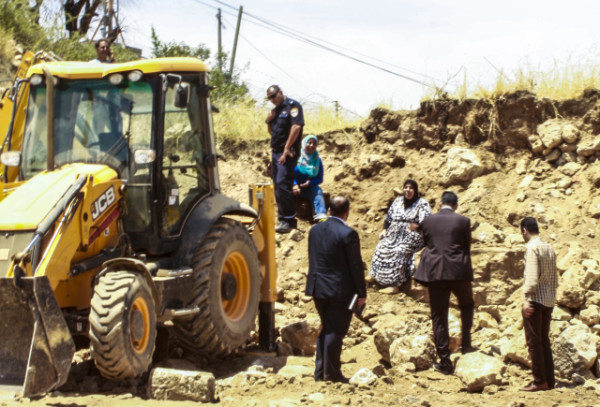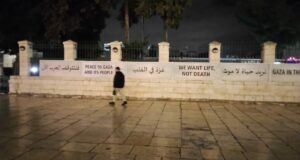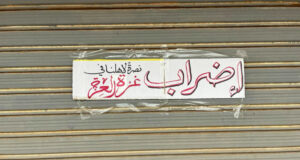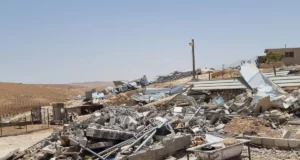31th May 2014 | Christian Peacemakers Team | Hebron, Occupied Palestine

Arwa (top left) and Faryel Abu Haikal climb onto their land to halt the demolition of their property from the Israeli Antiquity Authority, hoping to enforce a police order previously issued (photo by Christian Peacemakers Team Palestine).
With only a sliver of their land left to protect, having their entire lot of land encircled by Israeli settlements, Faryel and Arwa Abu Haikal climbed over a pile of rubble and boulders and stopped the Israeli bulldozer from shearing further into their property, dumping their dignity into the back of a dump truck, and hauling away their rights. There they stood under the unrelenting sun, staring into the teeth of the approaching bucket excavator, protecting their land from the ever encroaching Israeli settlement enterprise, facing arrest and physical assault – a reality they have faced for decades. Their resilience and steadfastness held off the Israeli Antiquity Authority (I.A.A.) for at least a few hours.
The I.A.A. continues to deploy a variety of tactics to annex privately owned Palestinian land on the hill top of Hebron, including ignoring previous orders issued by the Israeli police to halt work. Under the directive of Emmanuel Eisenberg, the I.A.A. project coordinator, the excavator bucket began carving deeper into Faryel Abu Haikal’s land, breaking both Israeli and international law in the process.
“They don’t know where the land is,” said Eisenberg about the Abu Haikal’s resistance to the archeological dig. “We will keep working. We are like the wagon that goes by the barking dog: The wagon keeps going and the dog keeps barking.”
In many ways, it’s hard to disagree with Eisenberg on the trajectory of the illegal settlement expansion in the West Bank and the recent illegal activity in Hebron. More than 1,500 hundred shops or homesteads have either been squatted or blocked off, creating a Hebronite Diaspora of several tens of thousands of Palestinians. The Hebronite refugee population didn’t happen all at once, but rather has occurred and continues to occur in a system of apartheid which operates with immunity.
Since Rabbi Moshe Levinger first led his caravan to the Park Hotel in the heart of Hebron to establish the Kiryat Arba settlement in 1967, the Jewish settlers have slowly, inch by inch, piece by piece, constructed an elaborate security apparatus that only Israelis have the keys to. In Hebron, there are over 130 road blocks, dead end streets, check points, and military patrols that restrict Palestinian access to their city.
The Abu Haikal’s land and life is a microcosm of the principles of ethnic cleansing at work across Palestine today.
For the sake of expediency, this is just a short history of the aggression and assault that the Abu Haikal family has endured at the hands of the Jewish settlers and the Israeli security forces while trying to maintain a home to raise their family.
In 1984, Jewish settlers first arrived on Tel Rumeida, the historical hilltop neighborhood of Hebron, which, according to some religious texts, is where Abraham first laid claim to land. It is this historical interpretation that provides impetus for archeological digs to establish exclusive Jewish claims to the hilltop. The Tel Rumeida settlement stands today on concrete pylons built directly on a previous archeological dig. This marked the genesis of the heightened tensions that would continually boil over and spill onto the Abu Haikal’s land year after year.
The next year, the Abu Haikal family’s land was trespassed by settlers looking to establish religious significance on the land by praying on it, a tactical first step that often leads to the construction of a synagogue.
A few years later in 1991, the Israeli Army sent a formal letter to the family informing them that they were confiscating parts of their land (plot 54) for military purposes, which then was reconstructed into an army barracks. To this day, the Abu Haikal family has a military base in their backyard, a backyard that for generations has been cultivated by their family. Their field of family memories is now the staging grounds for night raids into Palestinian homes.
The following year, settlers brought a caravan to another corner of the Abu Haikal land (plot 53). Fortunately, they were able to halt the annexation of that plot – temporarily.
February 25, 1994, is a day that will live in infamy. The American-born, Jewish religious extremist Baruch Goldstein entered the Cave of the Patriarchs, killing 29 Palestinian Muslim worshipers and wounding another 125. The following day, the Israeli military responded by taking over the Mosque of the 40 Companions which had been on the land of the Abu Haikals for centuries. Their place of religious sanctuary was stripped out from underneath of them, even though it had little connection to the incident.
As the construction continued on the illegal settlement near their house and the Jewish extremist population of Hebron started to swell, the attacks on their land and family continued in frequency and heightened in intensity.
On July 2, 1998, Jewish settlers cut down three trees on their property and brought a bulldozer to uproot more, but the family was able to utilize the law and nonviolently halt the destruction of their property.
A year later, in July, the internet icon of settler violence in Hebron, Anat Cohen along with her children and eight settlers, trespassed on their property (plot 54) using a footpath between the Abu Haikal houses to the settlement. The Abu Haikal family objected and the settlers, as they had so many times before, resorted to violence. Escalations involving 40 settlers erupted, and a settler with a wooden stick bludgeoned Arwa Abu Haikal, seriously injuring her. Despite the trespassing settlers and the initial aggressions, it was the Abu Haikal family that was issued fines, having to pay 1,500 shekels.
The settlement expansion continued under the guidance of a familiar face: Emmanuel Eisenberg. Eisenberg was responsible for the oversight of the archeological dig that led to the illegal settlement of Ramat Yishai in Tel Rumeida.
Despite the years of attacks and threats of land confiscation, on Jan 22, 2000, the Abu Haikals renewed the rental agreement with the Israeli Authorities and paid a year in advance, keeping the hope that justice would be realized. Signing the protection tenancy wasn’t about the land for them, it was a commitment to resist the illegal settlement expansion, knowing that years of harassment and violence awaited them.
Within three months, 70 settlers had occupied their land inside a structure. The Abu Haikals again called the police to evict the settlers from their land. The rule of law prevailed in that moment, but the leniency, which borders on absolute impunity, led to almost 100 settlers again attacking the Abu Haikal family on their land. Again, it was the Abu Haikals who had to pay 3,000 shekels in the aftermath.
When the Second Intifada broke out in September 2002, the pressure cooker which is Tel Rumeida, was quickly turned into a strategic Israeli military asset, and homes overlooking the city had their rooftops transformed into lookout towers and sniper positions. The Call to Prayer, the spiritual serenade from the mosques on the hill top, was replaced by the sounds of bullets cutting through the air and rocketing through their neighbors’ houses. For the next three years, curfews would further restrict the ability of the Abu Haikal family and others to even leave their house and provide for their family.
Shortly after the Second Intifada erupted, Wadea Abu Haikal (age 16) was attacked on the street in front of the house, and the stones hurled by the settlers broke his nose. The soldiers explained they could not protect the family, and prevented them from accessing their front path to the road in front of the settlement.
The Israeli authority then approached the Abu Haikals about putting a fence around their plots of land (53, 52) to help keep out the settlers. The key to the gate was never handed over the family.
One month later, the Israeli authorities refused to accept their rent, and plots 53 and 52 were declared a closed military zone. The fruit orchards would soon bear their last harvest.
The same year in September, despite being a closed military zone, Israeli settlers celebrated Sukkot on plot 52, building a wooden structure associated with the holiday on their land. A few weeks later, the booth was dismantled by the Israeli authorities. The settlers responded to Faryel Abu Haikal’s petition to remove the illegal booth by attacking her on the way home from school where she worked.
During the 2002-03 military campaign, it was normal for the military to show up during the month of Ramadan, a holy time for Muslims who fast during the day and then at sunset, break their fast in communion with their family. Routinely the military showed up and pulled the family out of the house to disrupt their religious practices. The Abu Haikals creatively resisted, preparing tea and taking nuts and seeds with them as the guards sat them on the ground. They refused give up their tradition, their religious rights.
October 22, 2003 was a day that changed Arwa Abu Haikal’s life. A Palestinian was shot. Knowing that soldiers would quickly mobilize to shut down roads and lock down access paths to her home and that her younger siblings would need to be attended to, she left her work at Bab Al Zaweyah, a 20-minute walk up hill to her house. As she walked down the road, a soldier stopped her and held a gun to her head, threatening her life if she continued her walk to her home. Frightened, but undeterred, she continued, forcing the soldier to make the decision between murder and humanity. Shortly after, the IDF brigade besieged the house, dragging the family out onto the street. Her parents were unable to preempt the lockdown and had to wait until 1:30 am before the streets were reopened. As the parents waited anxiously, not knowing if their children were safe, the children sat by themselves outside the home in the cold and the dark. The Israeli military proceeded to unload round after round from their machine guns into the walls, furniture, closets, and cherished belongings while the family sat helplessly outside. Some of the holes remain today.
Two days later, the soldiers returned and took the mother of the household, Faryel, into a separate room and questioned her for four hours as the rest of the family sat helplessly.
The following year, the settlement expansion continued and Jewish extremists took control of the elderly Al Bakri couple’s home nearby. They later build structures on the Al Bakri garden. The close proximity to the Abu Haikal’s house led an increase in frequency of attacks on their home, forcing them to put metal cages around their windows.
“Our windows have been broken several times over the years, until finally we were forced to put metal grates around them,” said Faryel Abu Haikal. The Abu Haikal had to replace the windows with their home money, a situation unique to the occupation: the oppressed have to pay for the aggression of the oppressor.
The settlers found other ways to cause damage to the family’s home in the hopes of driving them off the land.
Settlers systematically razed the olive trees and stole their harvest. When their grape vines had matured, those too were consumed by the indifference of extreme Jewish ideology. Fires to their dried up field continued over the next several years. By 2006, half of the trees on plot 52 had been cut down and destroyed by settlers, and what was left had been burnt by almost continuous arson.
Two years later in December of 2009, the military entered the Abu Haikal house, pointing their guns in the face of the males in the room. The women of the house stood between the guns and their men. The soldiers responded with extreme force and attacked the family, many of whom were badly beaten. The four who had resisted the assault were arrested and had to pay a 1,000-shekel fine a piece.
Over the next four years, settlers held women’s Torah groups on plot 52, right outside the family’s salon, singing, discussing the Jewish heritage of the land, and praying in the hopes of establishing a synagogue.
The repeated attempts by Jewish settlers to establish claims to the land continued, as they planted 200 vine plants and an irrigation system on plot 52, forcing the Abu Haikal family to seek legal remedy. Again, they had to take time off from work, renegotiate responsibilities away from the home, and convince the Israeli police to intervene. After six long weeks the army removed the vines.
A short time later, Israeli soldiers helped settler children build a tree house in the big ancient olive tree on the Abu Haikal land, next to the soldiers look-out structure. It took the police three hours to remove the children.
In April of 2012, the settlers cut more trees on plot 52, again with the protection of soldiers. The Abu Haikals continued to advocate and speak up in the hopes that one day the international community would respond.
On January 5th, 2014, Emmanuel Eisenberg returned to attend to unfinished business. Settler “archaeologists” from the Israel Antiquities Authority and Ariel University moved onto plot 52 with a bulldozer and two containers. The Abu Haikal family protested, and Sami Abu Haikal was detained. The settlers uprooted all the almond trees immediately and began with the illegal excavations.
There was a small victory in the small Palestinian neighborhood in Tel Rumeida. In 2014, Israeli High Court granted possession and the return of Al Bakri family land . . . but ordered the family to pay the police the costs for 50 police officers to remove the settlers. The court would attempt to recover the cost of eviction from the Jewish settlers. That has yet to happen.
One month later, plot 53 was consumed by the archeological dig that was never about archeology, but rather the establishment of a biblical museum. On February 5th, 2014, the I.A.A. moved onto plot 53 with a bulldozer and uprooted all the cherry trees. It also blocked a well-used right-of-way and replaced it with a longer, narrow footpath around the edge of the property that descends a steep, precarious slope.
Despite their land being confiscated, a week and a half later the Abu Haikals paid their rent up to 2015 in order to confirm their continued legal ownership of the land. The money was accepted by the Israeli institution, but excavations continued.
On February 19th, 2014, settler archaeologists uncovered a Muslim grave built of stone slabs directly on the bedrock and oriented to Mecca. Contrary to best archaeological practices and religious principles, they removed the grave.
Despite a police injunction to stop working, on March 26th, Emmanuel Eisenberg and David Ben Shlomo supervised the destruction of another section of the retaining wall, representing the border between plots 54 and 53. The Mayor of Hebron, Dr. Dawood Al Zatari, visited the area and stated that he was going to pursue legal remedy to the confiscation of land. His words have yet to lead to action.
Even after 20 years of extreme, systematic and planned abuse built by detailed policy after policy, the Abu Haikals continue to resist, even though so many times the expansion around their land has continued.
This week they were able to risk their lives in order reinforce a police order to stop working. The police orders should have stopped work, but as Eisenberg has said so many times, he doesn’t “give a shit,” and reminded everyone that at the end of the day, “We will keep working. We are like the wagon that goes by the barking dog: The wagon keeps going and the dog keeps barking.”
 International Solidarity Movement Nonviolence. Justice. Freedom.
International Solidarity Movement Nonviolence. Justice. Freedom.


